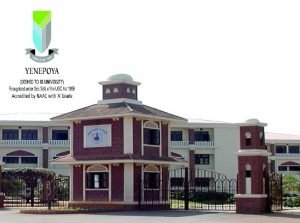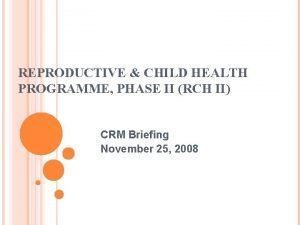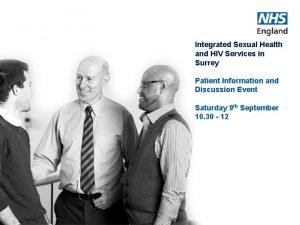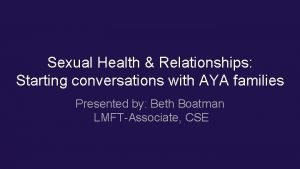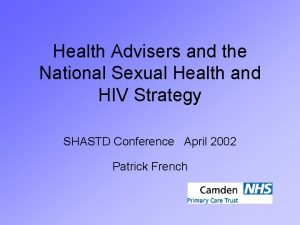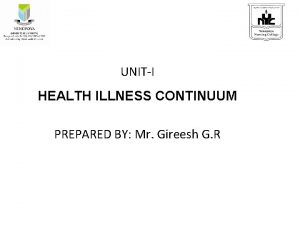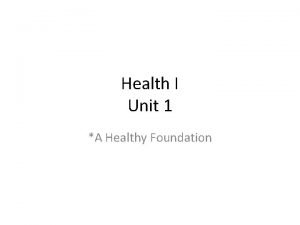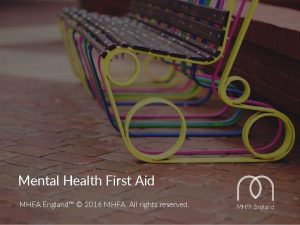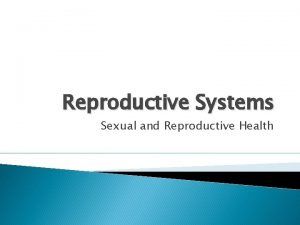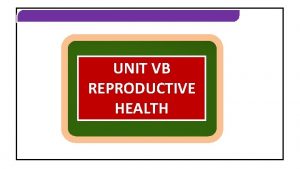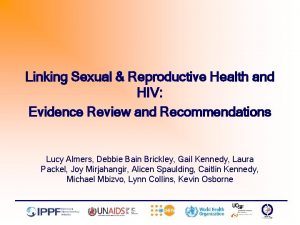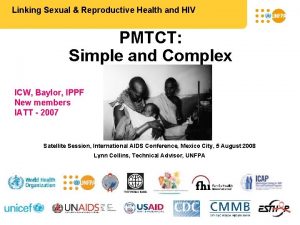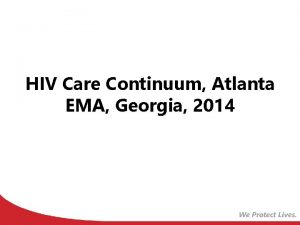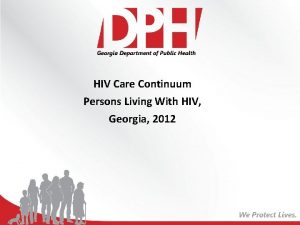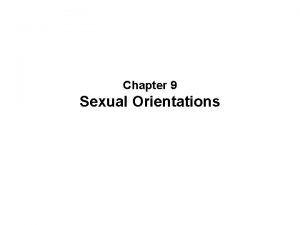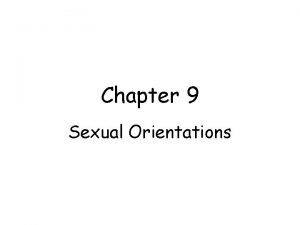Ensuring HIV and Sexual Reproductive Health continuum of















- Slides: 15

Ensuring HIV and Sexual Reproductive Health continuum of care for pre and post-release prisoners in Zambia Presenter: Derrick Malumo Prisoner Reintegration and Empowerment Organization - PREO

Presentation Outline � Country Profile � Data on HIV and TB in Zambian Prisons � Prison Experience � Life after Imprisonment � Opportunities for HIV/SRH/Prison Reform work in Zambia � Formation of PREO � PREO Registration Centre – Linking ex-prisoners to Health Services

Country Profile � Full name: Republic of Zambia � Population: 16. 59 million � Capital: Lusaka � President: H. E Edgar Chagwa Lungu � Area: 752, 614 sq km (290, 586 sq miles) � Major language: English (official), Bemba, Lozi, Nyanja, Tonga � Major religions: Christianity, indigenous beliefs, Hinduism, Islam � Life expectancy: 55 yrs (male) and 58 yrs (female) � Currency: Kwacha (ZMW) � Main exports: Copper, minerals, tobacco � Income Level: Lower middle income � GDP: $19. 55 billion � GNI per capita: $1, 480. 60 (World Bank, 2006) � HDI: 0. 586 (African Development Bank. 2014) Source: World Bank (2014); WHO (2014)

Data: HIV and TB in Prison Settings � HIV prevalence in prisons is at a record high - 27. 4% (Simooya and Nawa, 2011) : National Average is 11. 6%, as recorded by the Zambia Population-based Impact Assessment (ZAMPHIA, 2016). � Prevalence in Prisons is highest in Lusaka (42. 1%) and lowest in Solwezi (12. 7%) � HIV prevalence is highest among female prisoners (43. 3%) as compared to male prisoners (26%) � HIV Incidence at Lusaka Central Prison stands at 33% � TB (15 -20 times more than in the general population): The general population has a high TB burden of 387 cases per 100, 000 members of the population Source: � Simooya, O. O. & Nawa, S. (2011). A Sero- Behavioural Survey of HIV and AIDS Situation in Zambian Prisons. Ndola: Mission Press � Centre for Infection Disease Control in Zambia (2012). Alert: Zambia Prisons Paper. Lusaka: CIDRZ



Prison Experience in relation to Health � Overcrowding in prisons: This is a serious challenge in Zambia and makes it difficult to control the spread of communicable diseases like TB and HIV. v Slow judicial processes, custodial sentencing is more favoured as opposed to non-custodial sentencing v The population of prisoners in need of medical and health services is higher than that of officers in charge of healthcare in respective correctional facilities v Personal hygiene is almost impossible considering the high population against few sanitary facilities � Nutritional support for HIV positive prisoners: Providing nutritional support to those that require special care or those that are on HIV treatment remains a challenge. v Inadequate funding to the Prisons service is a contributing factor v Prisoners in Zambia only have one meaningful meal a day; this is a major challenge for those on HIV treatment, some opt out of treatment as a result. � Fear of stigma and discrimination from friends, families and communities v Stigma is a related challenge, since special diets are viewed as an indicator of an individuals’ health or disease status v Those who commence treatment in prison fear that when they are released, friends, families and communities will ask them how they contracted HIV in a prison setting where there are no sexual relations and fear that they will be accused to have engaged in same sex relations, a taboo

Prison Experience in relation to Health - Continued � Non availability of treatment support groups and counseling services. v Counseling is only done when a person is enrolled on treatment but many stop taking medication along the way, because of stress and depression arising from losing their freedom and missing their families � Non-supportive legal environment: Condoms are not available to prisoners despite the fact that sex is happening in prison. Sex between men is criminalized in Zambia. v This is contributing to the spread of sexually transmitted infections among prisoners � Non availability of shaving instruments v Lack of shaving instruments in Zambian prisons has resulted in prisoners having to share instruments, making it easy for the transmission of HIV.

Experience after prison life � Stigma and Discrimination: Usually by the family and community members � Linkages to the community upon release - Lack of continuation of care v There is no clearly defined referral system linking the prison health system with health services outside the prison system. It has been noted that some individuals entering prisons do not have documentation, which hinders their integration into a referral system. v Coupled with poor social safety nets for ex-prisoners on HIV treatment in the community, high mortality rates upon release are recorded. � Reintegration of Prisoners: Prisoners acquire skills in prison. However, there is urgent need to link them to income generating activities upon release. This will help reduce their vulnerability. HIV positive prisoners can lead productive lives.

Opportunities for HIV prevention/SRH /Prison Reform work in Zambia � Zambia Correctional Service – Legislative review process Draft Bill to be soon presented to Parliament (Compliant to Nelson Mandela Rules). � Transition from a penal to correctional model - Broadened the scope of prison reform in Zambia. The UNODC Prison Reform Programme, provides an opportunity to extend health initiatives in prison to the community. � National AIDS Strategic Framework (2017 -2021), includes prisoners as a key population – Opportunity to raise resources � Zambia Prisons Health Strategic Plan (2015 -2020). Enhanced coordination � Zambia Correctional Services Staff Training Curricula Review (2016). Incorporated HIV prevention � Formation of the Inter - Ministerial Committee (by the Ministry of Home Affairs) to oversee the welfare of ex-prisoners - This platform can enhance the reintegration of ex-prisoners in the community and provide linkage to much health needed services. � Partnership with the Planned Parenthood Association of Zambia (PPAZ) – Linking ex-prisoners to integrated health services.

Stigma and discrimination Poverty Repeated Crimes Recidivism Death Homelessness Sexual work HIV/AIDS Limited access to ART

Formation and activities of Prisoner Reintegration Organisation PREO was formed in January, 2014, with support from UNODC and has the following mandate: � Advocacy – With moral support from UNODC, PREO has continued to advocate for the respect and promotion of prisoners’ rights, anchored on the Nelson Mandela Rules. � Reintegration v Strengthen and facilitate referrals for HIV positive ex-prisoners - ensure ex -prisoners have access to treatment and related medical services v Link skilled ex-prisoners to income generating activities v Advocate against stigma and discrimination and facilitate for a conducive environment for released prisoners The ultimate aim is to ensure that released prisoners have food to compliment their treatment and shelter.

PREO Registration Centre (Initial Commitment from UNODC = $25, 000. 00) Linkages: Education, Income Generation/ Employment Linkages: Health Services Linkages: Family Ties, Legal Aid Services and Building Partnerships and Networking

PREO and PPAZ Partnership • Objective: To link ex-prisoners on treatment to health services in public health institutions and ensure continuum of care.

THANK YOU
 Characteristics of zygomycetes
Characteristics of zygomycetes Characteristics of eukarya
Characteristics of eukarya Principles to actions ensuring mathematical success for all
Principles to actions ensuring mathematical success for all Sexual health and relationships education scotland
Sexual health and relationships education scotland Rch launched in which year
Rch launched in which year Role of nurse in rch phase 2
Role of nurse in rch phase 2 Sti clinic st albans
Sti clinic st albans Redhill gum clinic
Redhill gum clinic What is sexual health
What is sexual health Sexual health
Sexual health Amy tishelman
Amy tishelman Society of sexual health advisers
Society of sexual health advisers Continuum of health
Continuum of health A person at the midpoint of the health continuum is
A person at the midpoint of the health continuum is Define health illness continuum
Define health illness continuum Mental health continuum mhfa
Mental health continuum mhfa




